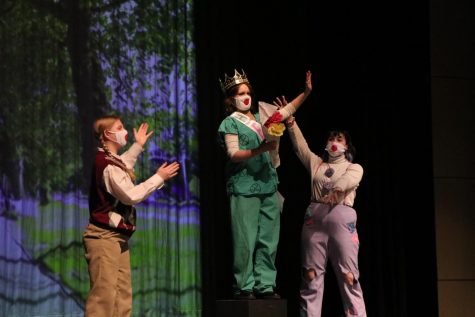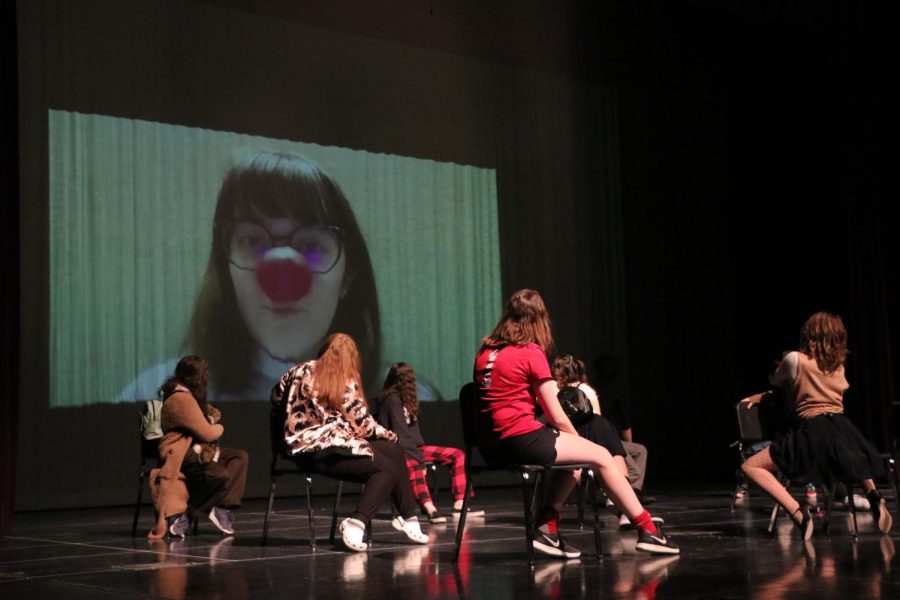Clowning around
Theatre students wrapped up their production of “Clown Show the Third: COVID Chronicles”
Photo courtesy of Kelsey Nunnenkamp
Presiding over her class, senior Isabella Reilly plays a teacher zooming in on the projection screen. During the rehearsal process, the cast and crew had little time to become prepared. “The show was heavy on props and projection needs,” director Brooke Phillips said. “We only met twice a week for a few weeks and the actors were able to take our writing from the officers and implement it right away. Since there was no script, everyone had to be in tune with each of the stories.”
March 5, 2021
Two dozen silhouettes scrambled to the stage with chairs in hand — circus music playing overhead — just in time for the lights above to shine down and illuminate the actors’ faces. Underneath a white mask with a bright-red nose decoration, the cast began speaking incoherent gibberish rather than normal dialogue. However, this vast array of babbling clowns did not surprise the audience, as it was a part of the Theatre Department’s “Clown Show the Third: COVID Chronicles.”
The department performed its silent sketch comedy show about clowns grappling with the COVID-19 pandemic for audiences on Feb. 25 and 26 in the school auditorium; however, the preparation for this show had been developing for months. Before the start of the second-half of the school year, theatre director Brooke Phillips sat down with the troupe’s seven Drama Officers to discuss plans for 2021—eventually coming to the idea of reviving the “Clown Show” for a third iteration.
“Michael Davis approached me saying with how weird this pandemic year was that it would be a good year to bring back the ‘Clown Show,’ so I approached the Officers with the concept and they loved the idea,” Phillips said. “I thought it would be fun and educational to get an outside expert opinion on our ideas and learn how to properly write a sketch.”
And that expert, Los Angeles-based comedy writer Matt Moore, joined the writing team on Zoom before rehearsals started to provide some advice on how to write a successful sketch comedy scene.
“The process for teaching students to create successful scenes starts with listening,” Moore said. “I explained the importance of keeping things simple. We would highlight the ‘funny thing’ that would happen in the scene, and then I would help them come up with ideas for how to create a pattern and heighten [it]. Comedy follows the ‘Rule of 3s’ where a [something] happens, it happens again a little bigger and then a third time solidifying a recognizable pattern. Once we figured out the funny thing and the pattern it would take, it was easy to ‘flesh it out’ and add all the other details.”
Though this show had the help of a professional comedy writer, the previous two had a different development process. Back in the 2002-2003 school year, former theatre director and current English teacher Michael Davis developed the idea for the “Clown Show” after attending an International Thespian Festival, where he watched another theatre company put on a similar production.
“[The troupe] actually did a workshop explaining their development and creative process,” Davis said. “It basically comes from an almost-improv angle to start, where you have a character and an objective and how is that character going to achieve that objective. You have a variety of characters and put them in different situations to see how those characters achieve their objectives.”
The “Clown Show 2” premiered three years after in the 2006-2007 school year, continuing the idea of a multitude of different clowns overcoming challenges; however, this time it utilized more technical elements to improve upon the first production.
“We did a lot with music,” Davis said. “We’d use popular music to create a mood, and see how that would develop the story, too. We also tried to incorporate a lot of audience participation. That always brought out a different element as well. Every performance might be slightly different if you have a different audience reaction or a different individual creating their influence on the scene.”
Now, after an almost 20 year hiatus, the “Clown Show” graced the stage once again, this time in the backdrop of one of the world’s largest pandemics ever.
Rather than primarily focusing and experimenting with different clown caricatures in a variety of situations, the third version explored how clowns would handle different COVID-related scenarios: ordering packages online, covering a busy news cycle, ordering DoorDash, attending school with depleted attendance and protesting.
However, unlike normal productions the department puts on, none of the actors could speak English, instead having to improvise gibberish to help move scenes along—proving to be a challenge for the actors involved with the show.

“One of my scenes was about two people indicating which package from a large pile of packages was theirs and fighting over them,” junior Nathan Bigler said. “I had to make everyone aware I was stopping the argument and coming to collect my box. So I had to make sure the audience knew from my posture that I was confused and the box I was trying to lift was heavy. It was a challenge to try to not use words and show through my body and gestures what I wanted so the audience wouldn’t be confused.”
Though the show ran just over 30 minutes in length, the message of the show aimed to not only relate on a personal level with the audience’s experiences in the pandemic but also show how important the arts can be in an environment where many are feeling isolated.
“We turn to stories, poetry, art, music and theatre to make sense of the world,” Phillips said. “Not only do plays reflect the time in which they were created, they bring us together to applaud, to cry and to laugh.When I heard the audience laugh… it was like breathing again after holding my theatrical breath for a year. It was really powerful to bring people safe, live entertainment, where we all laughed together.”
Continuing the previous two’s silent, gibberish comedy, “Clown Show the Third: COVID Chronicles,” simultaneously introduced the audience to goofy clowns and covered relatable experiences. A fourth “Clown Show” is not yet in the works, but the message the department wants to spread of the importance of art during the pandemic will continue as it is looking ahead to beginning its rehearsal process of its spring musical “The Addams Family: Quarantined Edition.”







